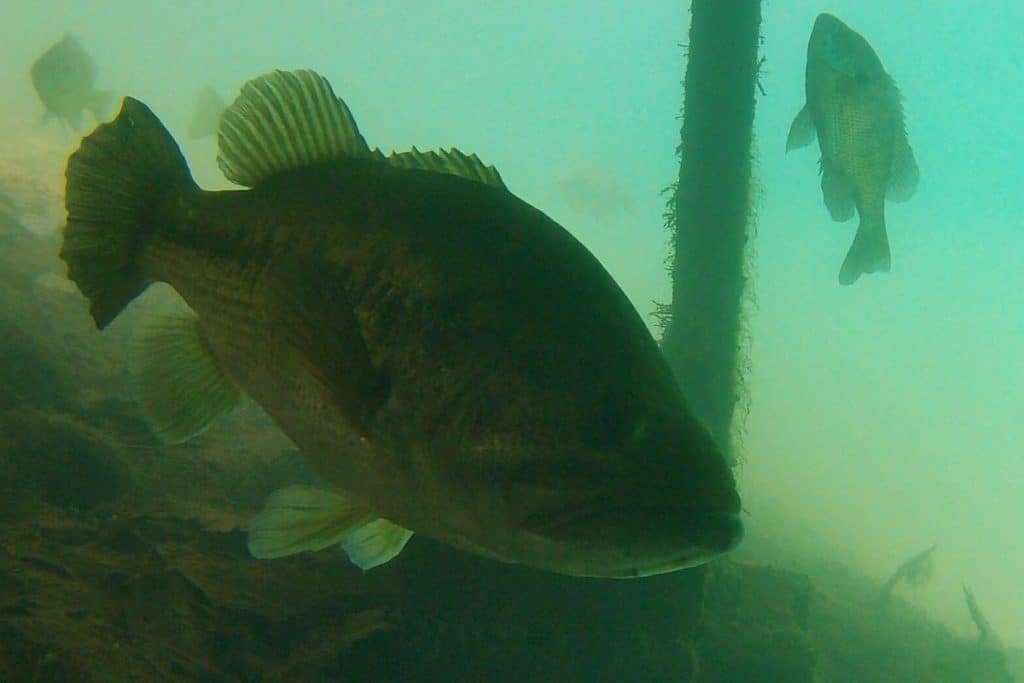There are hundreds of crankbait choices for anglers to consider. A flat-sided crankbait is something all bass enthusiasts should have ready. Especially when these conditions are present.
Flat-sided crankbaits are an excellent option when the water is cold. These lures also trick finicky bass into biting during tough conditions like cold fronts and heavy lake fishing pressure.
Understanding what a flat-sided crankbait does well and when to use them will allow you to catch bass on difficult days.
The Design of a Flat-Sided Crankbait
In the crankbait world, the wobble is everything.
Different lures work better than others at any given time. I have fished tournaments on Table Rock Lake where one model of deep diver never got a bite. I switched to another brand and caught a five-fish limit in about ten casts. The crazy thing is I was fishing those two lures in the exact same spot.
That’s the nature of crankbait fishing.
A flat-sided crankbait is designed to create a tighter wobble. Not as compact as a lipless crankbait, but definitely not the wide pattern created by round-bodied lures.
This offers a different vibration pattern in the water.
While the lateral line on bass cannot detect vibration from a great distance, it is very sensitive to vibration patterns within a few feet of them. When the bite is difficult, the more subtle action of a flat-sided crankbait is different.

The Flat-Sided Crankbait and Cold Water
This is what most anglers think about when using flat sides. The lure has long been proven as a cold water powerhouse.
The term “cold water” is often misunderstood though.
Bass fishing was born in the deep south. Cold water in the lower portions of the United States may be fifty degrees while the bass up north are under two feet of ice.
Any time the water dips below the sixty-degree mark, flat sides will be considered.

Slowing a lure down during the cooler months can be a powerful strategy. The flat-sided crankbaits can be brought back at a much more controlled pace and still produce. The burning methods of their fat, square-billed cousins are best suited for warmer months.
While cooler water temps are excellent times to pull out flat sides, there are other situations where they can outperform round-bodied lures.
Cold Front Bass and Flat-Sided Crankbaits
Severe cold fronts are something bass anglers despise. Understanding where cold-front bass go will help us continue to catch fish.
The flat-sided crankbait, in conjunction with your favorite finesse technique, is a one-two punch for cold front bass.
When filming bass underwater after cold fronts, I learned some valuable information. Most of the time those fish did not move very far. In fact, the bass only slipped to the bottom edge of the cover or structure they were hanging around before the front hit.
Here are two examples.
I have lots of bass that hang near my floating dock. It is the first sizable piece of cover in the bay I live on off of the main lake. When a cold front hits, those bass will no longer be under the dock, but they are still close. They slip down the slope of the lake bed to the point where the slope stops and the flat bottom starts. In this bay, that is about ten feet down. The fish are still exactly in-line with the dock, just a few feet below it.

The same thing happens when I film bass hanging out on the rocks at a boat ramp. The rip rap that is there to stop prop wash is a magnet for bass. After a cold front moves in, those fish slip to the bottom edge of that rock instead of cruising around the top edge.
This was only a movement of about fifteen feet.
A flat-sided crankbait is an excellent searching tool. If the water you are fishing is one that you are familiar with, then use this crankbait to probe and search areas that were holding bass before the cold front hit.
I like to think of the flat-sided crankbait as a finesse lure that still allows anglers to cover water and search for fish. Trying to locate bass with a traditional finesse lure, like a shaky head, can take forever. It is a slow presentation that prohibits us from covering a lot of territory.
The flat side can cover that vast area.
Once you get a cold front bass to bite, follow, or otherwise reveal itself, then you always have the option to pull out that shaky head and work an area carefully and in detail.
(Here is an article that talks about when tiny crankbaits excel.)
Flat-Sided Crankbaits and Dealing With Fishing Pressure
We love sunny days. The bass – not so much.
That sun will drive the fish into the shade. That can be shade created by shallow cover or shade that is provided by depth.
In these situations, the other anglers on the lake will also be targeting the shade. The flat side is something the fish probably haven’t been seeing. When the boat ramps are full on busy weekends, the bass may see hundreds of weightless wacky rigs falling in front of them. That flat side is different and worth trying.

It can be worked around cover, deflect off of branches, and bounce off rocks like any crankbait. Yet that subtle wiggle and different vibration signature is unique.
We cannot underestimate the power of using a lure that the fish have not seen a thousand times. Bass can become conditioned to certain stimuli. While there is much debate on how long that memory can last, there is no doubt it does make an impact.
One of the challenges of dealing with fishing pressure is finding the bass. As I mentioned earlier, finesse lures are great for catching bass when conditions are tough but these presentations are not usually the best for covering water to find them.
A flat side in combination with a more traditional finesse offering can be a powerful tool to locate and catch bass when the lakes are crowded.
Keep a Variety of Flat-Sided Crankbaits Available
We already talked about the importance of crankbait wobble. One day a certain lure will catch them and the next it won’t.
Cycling through your crankbait collection to find that right wiggle and vibration pattern is an important process.
Having several different flat-sided crankbaits in your collection will help dial in the bite. It is also a good idea to have some that run in that mid-range, five-to-ten feet, and then some that work deeper than that.
Most flat sides are silent runners lacking the rattle of the deep divers and squarebills. This is another factor that helps to differentiate them from the lures other anglers are using.
Good luck out there and make sure to encourage someone today. You never know how you may change their life forever.
Isaiah 6:8

